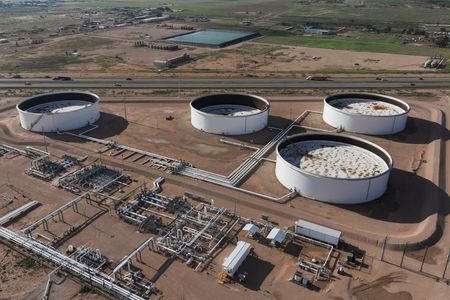By Yuka Obayashi and Trixie Yap
(Reuters) -Oil prices rose on Thursday, recovering from a five-day losing streak, on signs of steady demand in the United States, the world’s largest oil consumer, although concerns over the economic impact of U.S. tariffs capped gains.
Brent crude futures was up 41 cents, or 0.6%, at $67.3 a barrel, as of 0607 GMT.
U.S. West Texas Intermediate crude climbed 0.6% to $64.76, gaining 41 cents.
Both benchmarks slid about 1% on Wednesday to their lowest levels in eight weeks following U.S. President Donald Trump’s remarks on progress in talks with Moscow.
Trump could meet Russian President Vladimir Putin as soon as next week, a White House official said, though the U.S. continued preparations to impose secondary sanctions, including potentially on China, to pressure Moscow to end the war in Ukraine.
Russia is the world’s second-biggest producer of crude after the United States.
Still, oil markets found support from a bigger-than-expected draw in U.S. crude inventories last week.
The Energy Information Administration said on Wednesday that U.S. crude oil stockpiles fell by 3 million barrels to 423.7 million barrels in the week ended August 1, exceeding analysts’ expectations in a Reuters poll for a 591,000-barrel draw.[EIA/S]
Inventories fell as U.S. crude exports climbed and refinery runs climbed, with utilization on the Gulf Coast, the country’s biggest refining region, and the West Coast climbing to their highest since 2023.
Analysts at JP Morgan said in a note that global oil demand through August 5 has averaged 104.7 million barrels per day, tracking annual growth of 300,000 bpd, but 90,000 bpd below their forecast for the month.
“Despite a slightly soft start to the month, relative to our expectations, high frequency indicators of oil demand suggest global oil consumption is likely to improve sequentially over the coming weeks,” the analysts said, with jet fuel and petrochemical feedstocks anticipated to drive the consumption growth.
Meanwhile, China’s crude oil imports in July dipped 5.4% from June but were still up 11.5% year-on-year, with analysts expecting refining activity to remain firm in the near term.
Still, global macroeconomic uncertainty after the U.S. ordered a fresh set of tariffs on Indian goods capped price gains.
Trump on Wednesday imposed an additional 25% tariff on Indian goods, citing their continued imports of Russian oil. The new import tax will go into effect 21 days after August 7.
“While these new duties (on India by the U.S.) are set to take effect in three weeks, markets are already pricing in the downstream ripple effects on trade flows, emerging market demand, and broader energy diplomacy,” said Phillip Nova’s senior market analyst Priyanka Sachdeva.
Trump also said he could announce further tariffs on China similar to the 25% duties announced earlier on India over its purchases of Russian oil.
“Tariffs are likely to harm the global economy, which will ultimately affect fuel demand,” said Phillip Nova’s Sachdeva, adding that markets are overlooking the fact that its impact will still be much greater on the U.S. economy and inflation.
(Reporting by Yuka Obayashi and Trixie Yap; Editing by Christian Schmollinger and Sherry Jacob-Phillips)










